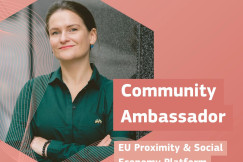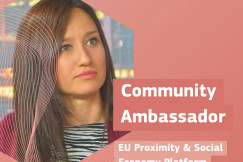Articles
26 March 2025
Observatory on Proximity in Italy IV report | 2024 Impact Proximity
Articles
26 March 2025
Skills
Urban and Rural Wellbeing
Working conditions and governance
+7 more
Login / create an account to be able to react
-
39
The National Observatory on Proximity, curated by Laura Bongiovanni (Isnet Association) and Carlo Andorlini (University of Florence), investigated at periodic intervals using qualitative and quantitative research tools, the evolution of Proximity in Italy. This is understood as a model of intervention characterised by actions and processes generated by people, informal groups, and organisations that intentionally come together by collaborating to respond in a concrete and shared way to a desire expressed by a specific territorial context, activating reciprocity and relational goods. The analysis is being previewed at the Biennale della prossimità event, a traveling event representing some of the most significant experiences converging from all over Italy.
The fourth edition of the Observatory (2024) focused on the transformative aspects, such as, the changes generated by proximity practices. The research was conducted using the theoretical framework of “Theory of Change” and involved the use of qualitative and quantitative research techniques, as well as the calculation of the SROI (Social Return On Investment) index. The qualitative analysis led to the identification of 20 outcomes, i.e., effects-changes generated by the neighborhood initiatives examined.
Quantitative analysis allowed us to verify the degree of diffusion and intensity of these outcomes. The effect found in all practices refers to the increase in free activities by stakeholders, however, 9 other outcomes exceed 70% diffusion among outreach initiatives. Through the adjustment operations (see Theory of Change), it was possible to calculate the causality index, i.e., the link and causal link between activities and outcomes; this was found to be 0.44 (0-1 scale), which can be interpreted as a high impact index according to the ISNET Association database benchmarks.
In addition, from the analysis, it was observed that all initiatives have at least one of the following characteristics: (1) they are new ways of learning and increasing shared skills; (2) they promote the growth of self-esteem in all those involved; and (3) they generate a new interconnection between individual and community. The fourth edition of the Observatory was completed with the calculation of the Social Return On Investment (SROI) index for the change (outcome) with the greatest diffusion, i.e., “the increase in free activities by stakeholders.” The SROI index is a summary measure that measures the social return on investment by relating the resources used to the social value generated. The index was found to be 1.27, an appreciable value considering that it was generated by a single change.
The fourth edition of the research is supported by Fondazione Impresa Sensibile and Fondazione Modena.
Topics
Italy
NGOs / Non-profits
SMEs (a company with less than 250 employees)
Social Economy Entity
-
Thematic area
-
-
Skills
-
Urban and Rural Wellbeing
-
Working conditions and governance
-
-
Interlinkages with other sectors
-
-
Proximity and social economy
-
-
Action areas and keywords
-
-
Digital social innovation
-
Innovation
-
Innovation as enabler for green transition and business development in the social economy
-
-
Ecosystem focus
-
-
Proximity economy
-
Social economy
-
-
Scope of activity
-
-
National
-
Share
PROXIMITY
The term proximity refers to the ability of people and organisations to confront each other and thus to work together by acting personally and concretely to realise an aspiration or to respond to a shared need. Since 2017, the Biennale della Prossimità has been held in Italy. The first edition in Genoa, then in Bologna, Taranto, Brescia and in 2024 in Naples. The Biennale is an experience made of encounters, exchanges and above all the growth of a common feeling around the word proximity. More than an event of events, Biennale of Proximity is a collective growth yard for the organizations and people who meet. It has a culminating moment with a three-day event, but in fact develops bonds and permanent shared planning.
PROXIMITY OBSERVATORY
Since the second edition of the Biennial of Proximity, a working group coordinated by Laura Bongiovanni (President of ISNET Association) and Carlo Andorlini (University of Florence), dedicated to the knowledge and analysis of the characteristics and evolution of the phenomenon, has been established. The Biennial from this moment is positioned not only as a moment of animation and confrontation, but also as a place for reflection and knowledge beyond the duration of the event, with the establishment of a permanent Observatory and a database of quantitative and qualitative indicators for reading the phenomenon.
The first edition of the Observatory had returned the image of proximity as a fluid phenomenon with great capacity for innovation but with strong limitations in structuring. Outreach initiatives had often turned out to be the result of very particular circumstances and relatively short time durations, resulting in the risk of dispersion of the wealth of knowledge and experience generated.
The second edition highlighted the ability of outreach initiatives to confront unexpected events and processes, using volatility and disorder, even mistakes, as a stimulus for evolution and development of interconnections.
The third edition delved into these aspects and observed some factors in outreach initiatives; 10 characteristic elements emerged that were recognized as “recurring” in the majority of the observed experiences.
The fourth edition, which has just been completed, focused on social impact, that is, the analysis of the effects and changes generated by outreach initiatives.
RESULTS OF THE 4TH EDITION OF THE PROXIMITY OBSERVATORY
For the pursuit of the cognitive objectives, first of all, the object of observation was chosen. A census of proximity experiences in all their varied expressions is lacking to date; the fluidity, originality novelty of the phenomenon means that a statistical reference population is not yet available. Consequently, it was decided to elect some case studies, selected according to the following criteria:
- Experiences with a co-presence of established and new practices;
- Experiences located in various parts of Italy;
- Experiences of small, medium and large organisational and management size;
- Experiences located in both small, medium and large urban centers;
- Experiences, finally, developed with public, private and third sector matrices.
Based on these elements a panel of 16 outreach initiatives was composed.
The areas of activity pursue objectives of labour and social inclusion, countering educational poverty, cultural animation, and promoting sustainable consumption and target young people in precarious conditions, the unemployed, the disabled, and fragile children by developing a multiplicity of interventions.
Some examples are: a skills bank offering solutions to tasks, problems, daily needs; neighbourhood gatehouses i.e., physical spaces of listening and support to citizens, capable of catalysing the needs and, at the same time, the skills of citizens who wish to invest part of their time in favor of the community; community emporiums with the enhancement of ethical and sustainable supplies; initiatives to regenerate the urban fabric of the neighbourhood through the promotion and support of activities of restoration and enhancement of the artistic archaeological heritage, just to name a few examples.
THE OBJECT OF THE RESEARCH
Beyond the specificity of the initiatives, what characterises the outreach experiences is not so much the “what” is done, but the “how” the intervention is carried out. All practices, although they are in varying geometries, converge on the theme of participation and participation in the actions of a plurality of people to produce a common good. This modality has reinforced the belief that proximity acts as a trigger for gratuitous and disinterested activities on the part of stakeholders, activities that cannot be defined as voluntary work, but for all intents and purposes can be equated with it. For this reason, the main objective was to understand the social impact in terms of the capacity of initiatives in triggering the practices of free and disinterested activities.
To this main objective were added others, again in the logic of assessing the social impact capacity of outreach initiatives.
METHODOLOGY
From a methodological point of view, we referred to the “Theory of Change.” The “Theory of Change” assumes that given resources (inputs) used to carry out processes (activities), solutions (outputs) are obtained, which in turn generate results (outcomes) or rather effects and changes. Social impact is given by these changes (outcomes) net of:
- Effects that would have occurred anyway (Deadweight);
- Effects from other sources (Attribution);
- Diminishing effects in the long run (Drop-off);
- Negative consequences (Displacement).
Social impact is thus understood as benefit net of adjustment factors:
The qualitative phase: The filter used to read the practices was that of social innovation, i.e., what modes were able to produce change within that dimension that arises from the new relationship between people and organised systems. The instruments used were two: (1) the semi-structured interview with open and some closed questions, or depending on the contexts, the free interview with only a few defined macro-themes; (2) participant observation, an ethnographic research technique focused on the permanence and participation in the activities of the social group studied by the researcher, which allows us to see practice in action.
The quantitative phase: A structured questionnaire was prepared to test the frequencies, then the spread of the different effects and changes observed through the qualitative analysis. The questionnaire also included questions for gathering information useful for the operations of adjustment, that is, of the transformation of outcome values into social impact values (see “Theory of Change”). This made it possible, for each change variable, to calculate the impact index. The impact (or causality) index expresses the degree of relationship between a project's activities-in our case, outreach practices-and the effect generated in the stakeholders: citizens, beneficiaries, volunteers, and other stakeholders who performed activities for free to help the community. In other words, it represents the ability of actions to influence and bring about a given change. The impact index, therefore, provides an understanding of the extent to which observed changes can be directly attributed to the interventions implemented, thus providing a measure of the effectiveness of a project or program. The index provides a quantification of the causal relationship between activities and observed changes, and can be interpreted as a measure of overall effectiveness. The index ranges from 0 to 100, where: 0 indicates that the activities had no effect on the observed changes; 100 indicates that the activities completely brought about the change. L’Associazione Isnet, sulla base della propria esperienza in valutazioni e analisi di impatto sociale. ha sviluppato una banca datiii a partire dalla quale è stata ricavata una scala di valutazione per facilitare l’interpretazione dell’indice di impatto; i valori dell'indice vengono classificati in tre categorie: 0,0 – 25,0 = Basso livello di efficacia (Valore basso dell’indice di impatto); 25,1 – 40,0 = Medio livello di efficacia (Valore medio dell’indice di impatto); 40,1 – 100,0 = Alto livello di efficacia (Valore alto dell’indice di impatto).
Monetary analysis: Lastly, the main change variable under study was processed to calculate the SROI index. The ability of outreach initiatives to trigger free and disinterested collaborative behaviour was valued through proxy data; in particular, the hours devoted by stakeholders to free activities were considered in the same way as volunteer hours and valued in monetary terms through parameters not directly observed, but obtained from other research and studies. The total value obtained, net of adjustment operations, was placed in relation to the resources used to implement outreach initiatives; the ratio between the two values allowed the calculation of the SROI index.
Documents
Comments (0)
See also
-
29
Financing the Ecosystem Recap: December – January
- Categories
- Partnerships Regenerative Green Transition Skills +68 more
-
15
PSE Platform Ambassador highlight: Viktorija Bražiūnaitė, LISVA
- Categories
- Partnerships Regenerative Green Transition Skills +68 more
-
14
PSE Platform Ambassador highlight: Snezana Andric and Young Ambassadors
- Categories
- Partnerships Regenerative Green Transition Skills +68 more




